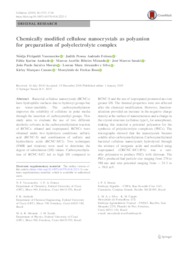Chemically modified cellulose nanocrystals as polyanion for preparation of polyelectrolyte complex.
Chemically modified cellulose nanocrystals as polyanion for preparation of polyelectrolyte complex.
Autoria: VASCONCELOS, N. F.; FEITOSA, J. P. A.; ANDRADE, F. K.; MIRANDA, M. A. R.; SASAKI, J. M.; MORAIS, J. P. S.; SILVA, L. M. A. e; CANUTO, K. M.; ROSA, M. de F.
Resumo: Bacterial cellulose nanocrystals (BCNCs) have hydrophilic surfaces due to hydroxyl groups but are water-insoluble. The carboxymethylation improves the solubility of cellulose in polar media through the insertion of carboxymethyl groups. This study aims to evaluate the use of two different alcoholic solvents in the carboxymethylation reaction of BCNCs: ethanol and isopropanol. BCNCs were obtained under two hydrolysis conditions: sulfuric acid (BCNC-S) and combination of sulfuric and hydrochloric acids (BCNC-S/Cl). Two techniques (NMR and titration) were used to determine the degree of substitution (DS) values. Carboxymethylation of BCNC-S/Cl led to high DS compared to BCNC-S and the use of isopropanol promoted an even greater DS. The thermal properties were not affected after the chemical modification. However, functionalization provided an increase in the negative charge density at the surface of nanostructures and a change in the crystal structure (cellulose type Ia for amorphous), making this material a potential polyanion for the synthesis of polyelectrolyte complexes (PECs). The micrographs showed that the nanocrystals became soluble after carboxymethylation. Carboxymethylated bacterial cellulose nanocrystals hydrolyzed through the mixture of inorganic acids and modified using isopropanol (CBCNC-S/Cl-IPA) was a suitable polyanion to produce PECs with chitosan. The PECs produced had particle size ranging from 276 to 588 nm and zeta potential ranging from - 24.3 to + 39.0 mV.
Ano de publicação: 2019
Tipo de publicação: Artigo de periódico
Unidade: Embrapa Algodão
Palavras-chave: Carboxymethylation, Chitosan, Hydrolysis, Nanocrystals, Polyelectrolytic complexes
Observações
1 - Por padrão são exibidas publicações dos últimos 20 anos. Para encontrar publicações mais antigas, configure o filtro ano de publicação, colocando o ano a partir do qual você deseja encontrar publicações. O filtro está na coluna da esquerda na busca acima.
2 - Para ler algumas publicações da Embrapa (apenas as que estão em formato ePub), é necessário ter, no celular ou computador, um desses softwares gratuitos. Sistemas Android: Google Play Livros; IOS: iBooks; Windows e Linux: software Calibre.
Acesse outras publicações
Acesse a Base de Dados da Pesquisa Agropecuária (BDPA) para consultar o acervo completo das bibliotecas da Embrapa.

